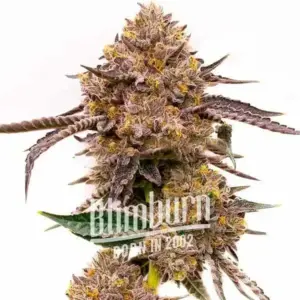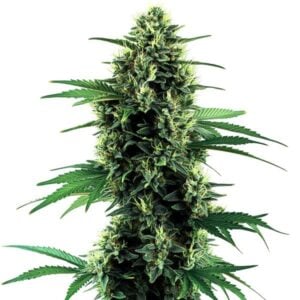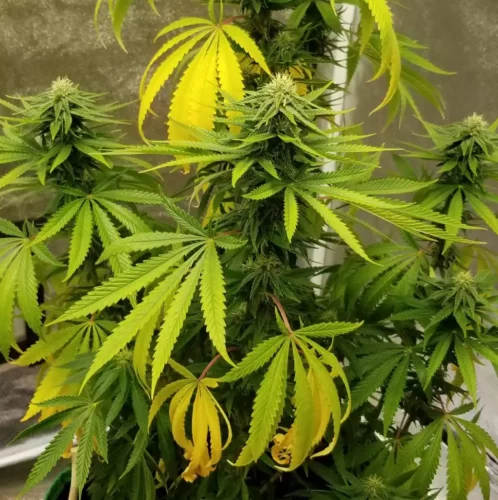Red Poison Autoflower Cannabis Seed Description
Red Poison Auto, a stunning visual and aromatic marvel, is making waves in the cannabis community. This Red Poison Autoflower variant, bred by Blimburn Seeds, showcases deep purple, almost red hues in its leaves and buds, making it a standout in any garden. This strain results from crossing Green Poison with an exotic autoflowering strain with purple traits, culminating in a plant that offers both aesthetic appeal and potent effects.
Red Poison Autoflower boasts a THC content ranging from 15% to 19%, making it moderately strong and suitable for both recreational and medicinal use. Its yield is impressive for an autoflowering variety, offering growers the chance to harvest generous amounts of resinous buds. When it comes to flavor and terpenes, this strain presents a unique blend of sweet and fruity aromas with a hint of Skunk, captivating the senses of any cannabis enthusiast.
Recommended Strains
Red Poison Auto
 THC: 20% - 22%
THC: 20% - 22% Type of seed: Autoflowering
Type of seed: Autoflowering Phenotype: Mostly Indica
Phenotype: Mostly Indica Day to flower: 8 weeks
Day to flower: 8 weeks
Promos & Deals
Environmental Requirements for Growing Red Poison Auto Strain
Red Poison Autoflower, like other cannabis strains, thrives under specific environmental conditions. Meeting these requirements is key to unleashing the full potential of your plants. This strain’s resilience and autoflowering characteristics make it adaptable to a variety of settings, but optimizing its environment can significantly enhance growth, potency, and terpene profiles.
Temperature
Red Poison Autoflower prefers a mild to warm climate, with daytime temperatures ideally between 68°F (20°C) and 80°F (27°C). At night, temperatures can drop slightly, but it’s important to avoid extreme cold, as this can stress the plants and potentially affect their growth and flowering. Autoflowers are generally more robust against fluctuations in temperature, but maintaining consistency will support optimal development. In regions with cooler climates, indoor cultivation or the use of a greenhouse can help maintain the necessary warmth.
Humidity
Humidity control is vital throughout the lifecycle of Red Poison Autoflower. During the vegetative stage, a higher humidity level of around 60-70% is beneficial for promoting healthy leaf growth. However, as the plant enters its flowering phase, reducing humidity to around 40-50% can help prevent the development of mold or mildew on the dense, resinous buds. Proper ventilation and air circulation are crucial for managing humidity levels, especially when growing indoors.
Lighting
Red Poison Autoflower’s unique autoflowering trait allows it to flower based on age rather than changes in light cycles. Despite this, providing ample light is essential for vigorous growth and optimal yield. When cultivated indoors, LED grow lights or full-spectrum lamps can deliver the intensity and spectrum of light needed throughout the plant’s life. These lights should be positioned to cover the canopy evenly and adjusted as the plants grow to prevent light burn. Outdoor growers should choose a location that receives plenty of direct sunlight for the majority of the day, ensuring plants can photosynthesize effectively.
Air Circulation and Ventilation
Good air circulation and ventilation are necessary to keep the growing environment fresh and to help control temperature and humidity. Indoor setups should include an exhaust fan to remove hot, humid air and intake fans or vents to bring in fresh, cooler air. Oscillating fans can also help strengthen plant stems by simulating natural wind, besides promoting a uniform environment around the plants. Outdoor growers should ensure their plants are not overcrowded and that natural breezes can pass through the garden space easily.
Soil and Water Quality
The quality of soil and water plays a significant role in the health and productivity of those plants. A well-draining soil mix rich in organic matter supports robust root development and efficient nutrient uptake. The pH of the soil should be monitored and maintained between 6.0 and 6.5 for optimal growth. Water quality, including pH and mineral content, should also be considered, as excessive minerals or improper pH can lead to nutrient lockout, affecting plant health. Using filtered or rainwater can sometimes offer a solution to these issues.
By carefully managing these environmental factors, growers can create the ideal conditions for Red Poison Autoflower to flourish. While this strain is forgiving and adaptable, paying close attention to its needs will lead to a more rewarding cultivation experience, yielding potent, flavorful buds that reflect the best qualities of this unique variety.
Setting Up The Growing Cannabis Space
Indoor Cannabis Cultivation
For those opting to cultivate Red Poison Autoflower indoors, setting up a grow tent or designated space with adequate ventilation and lighting is crucial. Utilizing LED grow lights can be particularly beneficial, offering a spectrum conducive to the plant’s growth stages while being energy-efficient. Ensuring proper air circulation with fans and an exhaust system will keep the environment within optimal conditions for your plants.
Outdoor Cannabis Cultivation
When growing this strain outdoors, choose a spot with ample sunlight and protect your plants from extreme weather conditions. Using pots or in-ground planting can both yield excellent results, with the former allowing for easier movement if necessary. It’s advisable to use organic soil enriched with natural nutrients to enhance the flavor profile of your harvest.
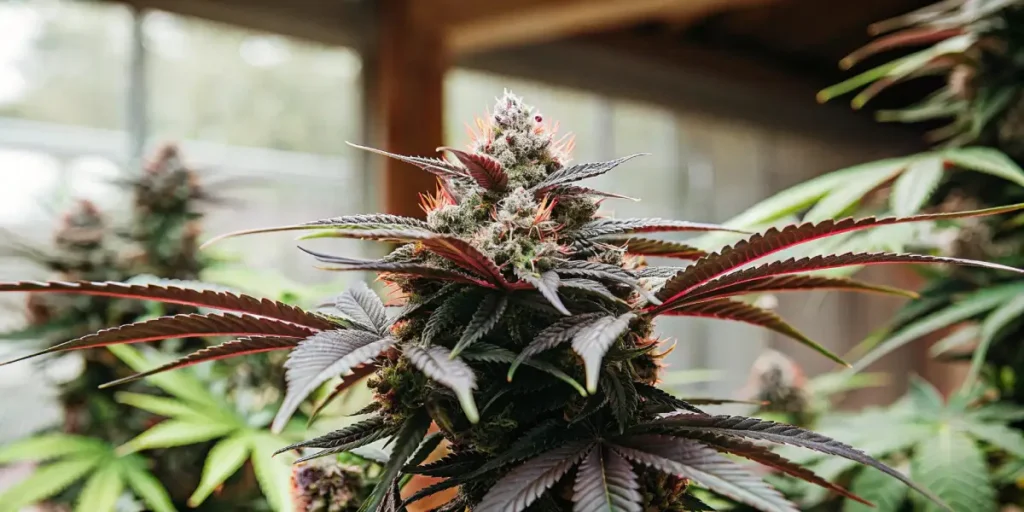
Propagation and Germination of Red Poison Autoflower Seeds
Starting with high-quality Red Poison Autoflower seeds from Blimburn Seeds ensures strong germination rates and genetic stability. The paper towel method remains a popular and effective way to germinate autoflower seeds. Keep the environment warm and moist, and within a few days, you should see taproots emerge, signaling they’re ready to be planted in their initial pots. It’s crucial to handle these delicate seedlings with care, avoiding any damage to the roots during transplantation.
Unlike photoperiod strains, Red Poison Autoflower begins flowering based on age rather than light cycle changes, making the germination and early care stages critical for establishing a strong growth foundation. This self-flowering trait allows growers to skip the strict light schedule adjustments necessary for inducing flowering in non-autoflowering varieties, simplifying the cultivation process significantly.
Vegetative Phase of Red Poison Autoflower
Red Poison Autoflower transitions into the vegetative stage shortly after germination. Given its autoflowering genetics, this period is relatively short but crucial. During this phase, plants focus on building a strong root system and foliage development. Optimal conditions involve maintaining moderate humidity and ensuring the plants receive plenty of light—ideally 18-24 hours a day—to support vigorous growth.
It’s essential to monitor plant health closely during this stage, adjusting water and nutrient intake as needed. Autoflowers, including Red Poison, are generally more sensitive to nutrient overfeeding, so a light hand is recommended. Utilizing a balanced, growth-focused nutrient formula that’s lower in nitrogen as the plant matures can prevent nutrient burn and encourage healthy development.
Flowering Phase of Red Poison Auto Seeds
The flowering stage is where this strain truly shines. As an autoflowering strain, it automatically shifts to flowering without the need for light cycle manipulation, typically beginning to flower around 2-4 weeks after germination. This phase can last anywhere from 5-7 weeks, during which the plant develops its characteristic deep purple-red buds that are dense and covered in trichomes.
During this stage, lowering humidity levels to around 40-50% can help prevent mold or bud rot, especially important given the dense bud structure of Red Poison. Switching to a bloom-specific nutrient formula can provide the phosphorus and potassium needed for optimal flower development. Additionally, maintaining a slightly cooler environment can enhance the coloration of the buds, bringing out the vibrant hues that make this strain so visually striking.
Cannabis Fertilization and Nutrition
Proper nutrition is vital throughout the life cycle of this strain. Autoflowers require a more delicate balance of nutrients compared to their photoperiod counterparts due to their quick growth cycle and smaller size. Start with a mild nutrient solution and gradually increase strength, paying close attention to the plant’s response to avoid overfeeding.
Incorporating a well-balanced, slow-release fertilizer at the beginning of the grow can simplify nutrition management. During the flowering phase, adding bloom enhancers rich in phosphorus and potassium supports bud development while maintaining lower nitrogen levels to avoid vegetative growth at this stage. CalMag supplements can also be beneficial to prevent common deficiencies seen in autoflowers.

Pest And Disease Control for Cannabis Growing
While Red Poison Seeds Autoflower’s resilience makes it less susceptible to pests and diseases, preventive measures are still crucial. Regular inspections can catch early signs of infestation or illness, allowing for swift intervention. Organic pest control methods, such as neem oil or insecticidal soap, can effectively manage minor issues without compromising the plant’s health or the environment.
Good hygiene practices, like cleaning tools and avoiding overwatering, can significantly reduce the risk of diseases. Employing companion planting with natural pest repellents like marigolds can also enhance your garden’s defense system, promoting a healthy grow space for your Red Poison Autoflower plants.
Harvesting and Curing for Cannabis Growing
The correct timing for harvesting Red Poison Autoflower is crucial for maximizing potency and flavor. Observing the trichomes’ color change to a milky white or amber indicates peak maturity. Since autoflowers have a set life cycle, most Red Poison plants will be ready for harvest around 8-10 weeks from germination.
After cutting down the plants, a proper dry and cure process is essential for developing the complex flavors and aromas Red Poison Autoflower is known for. Dry the buds slowly in a controlled environment with 50-60% humidity and temperatures around 60-70°F (15-21°C). Curing the dried buds in glass jars with daily burping for the first week helps to remove any remaining moisture, enhancing the smoking experience.
Red Poison Autoflower Weed: Indica or Sativa?
Red Poison Autoflower is predominantly an Indica-dominant hybrid, characterized by its quick flowering time, compact structure, and the deeply relaxing effects it produces. This genetic background contributes to its bushy, dense growth pattern and its potent physical effects, making it an excellent choice for those seeking relief from stress, pain, or insomnia. However, it also retains a Sativa influence, which can be seen in its uplifting and euphoric cerebral effects, offering a balanced experience that many users appreciate.
Advantages of Growing Red Poison Autoflower Cannabis Seeds
Growing Red Poison Autoflower presents numerous benefits for cultivators, especially those looking for a straightforward and rewarding growing experience. Its autoflowering nature eliminates the need for light cycle adjustments, making it an ideal choice for beginners or those with limited space. Additionally, its resilience and adaptability to various climates and environments allow for successful cultivation both indoors and outdoors.
Another significant advantage is the strain’s rapid life cycle, which enables multiple harvests in a single growing season when grown outdoors. Its stunning appearance, with vibrant purple-red buds, not only adds aesthetic value to your garden but also attracts interest in the final product. Lastly, the strain’s complex aroma and flavor profile, combined with its potent effects, make it a popular choice among consumers, potentially leading to a higher market demand.
Disadvantages of Growing Red Poison Auto Cannabis Seeds
Despite its many benefits, there are a few considerations to keep in mind when growing Red Poison Autoflower. Its smaller size, while advantageous for stealth and space, typically results in lower yield per plant compared to larger photoperiod strains. Autoflowers also have a set life cycle, giving growers less flexibility to correct mistakes or stressors that may affect the plant’s development, potentially impacting the overall yield and quality.
Furthermore, the intensive selection process for the strain’s unique coloration and effects means that maintaining genetic purity and stability is crucial, requiring sourcing seeds from reputable providers like Blimburn Seeds to ensure quality and consistency.
Why Buy Red Poison Autoflower Marijuana Seeds
Purchasing Red Poison Strain Autoflower is an excellent choice for both novice and experienced growers who value aesthetics, potency, and ease of growth. Its unique visual appeal, combined with a rich terpene profile and robust effects, makes it a standout strain in any collection. Additionally, its autoflowering and Indica-dominant characteristics offer a straightforward cultivation process with the benefit of a compact plant size, ideal for discreet growing scenarios.
Choosing seeds from Blimburn Seeds ensures access to top-quality genetics, maximizing your chances of a successful and satisfying grow. With the support of a trusted seed provider, cultivators can look forward to a hassle-free experience and a bountiful harvest of visually stunning and potent buds.
Common Problems in Cultivating Red Poison Autoflower Cannabis Seeds
While cultivating Red Poison Autoflower is generally less problematic due to its hardy nature, growers may encounter issues common to all cannabis cultivation, such as over or under-watering, nutrient imbalances, and pests or diseases. Due to their fast life cycle, autoflowers have less recovery time if these issues arise, making preventative care and close monitoring essential.
Another potential challenge is the strain’s sensitivity to light stress, despite its autoflowering traits. Although it doesn’t require light cycle changes to flower, excessive light intensity or inconsistent light schedules can stress the plant, affecting its growth and bud development.
Adhering to best practices in cannabis cultivation, such as maintaining optimal environmental conditions, using the right nutrients, and implementing regular health checks, can mitigate these risks, leading to a rewarding cultivation experience with Red Poison Autoflower.
In conclusion, Red Poison Autoflower is a versatile, visually appealing, and potent strain that offers a unique growing experience. Whether you’re a beginner or an experienced grower, its combination of aesthetic appeal, ease of cultivation, and satisfying effects make it a worthwhile addition to any garden. By purchasing high-quality seeds from a reputable source like Blimburn Seeds, cultivators can ensure the best possible start for a successful and enjoyable grow.
Similar strains
- Red Devil Auto: is a striking autoflowering hybrid known for its intense coloration, sweet berry flavor, and powerful yet balanced effects. This Indica-dominant cultivar produces deep red and purple hues under the right conditions, with buds coated in sticky resin and emitting aromas of ripe fruit, grape, and subtle spice.
- Maxigom Auto: is a robust and high-yielding autoflowering hybrid that stands out for its fruity-sweet flavor, rapid life cycle, and balanced effects.
- Fro-Yo Auto: is a flavorful and fast-flowering hybrid that combines creamy dessert terpenes with a balanced, feel-good high. Bred from Sunset Sherbet and Girl Scout Cookies genetics, this autoflower delivers sweet notes of vanilla, berries, and earthy undertones reminiscent of frozen yogurt with a fruity twist.
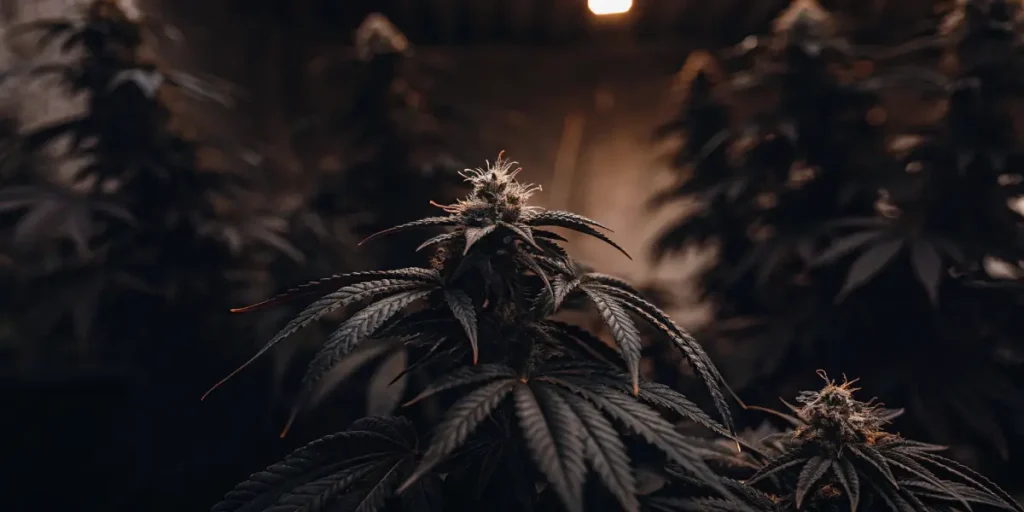
FAQs
What are the ideal growing conditions for Red Poison Autoflower?
Red Poison Autoflower thrives in mild to warm climates with daytime temperatures between 68°F (20°C) and 80°F (27°C). It requires moderate humidity control—around 60-70% during the vegetative stage and 40-50% during flowering to prevent mold. Providing ample light, whether from full-spectrum LED grow lights indoors or direct sunlight outdoors, is crucial for healthy growth. Proper ventilation, quality soil with a pH between 6.0 and 6.5, and controlled watering are also essential for optimal results.
How long does it take for Red Poison Autoflower to grow from seed to harvest?
Red Poison Autoflower has a fast-growing cycle, typically reaching harvest within 8-10 weeks from germination. It begins flowering automatically around 2-4 weeks after sprouting, eliminating the need for light cycle adjustments. The flowering stage lasts about 5-7 weeks, during which the plant develops its characteristic deep purple-red buds covered in resin.
What are the main benefits of growing Red Poison Autoflower?
Growing Red Poison Autoflower offers several advantages, including a short life cycle, easy cultivation process, and resistance to environmental fluctuations. Its autoflowering genetics make it ideal for beginners, as it doesn’t require strict light schedules to flower. Additionally, its compact size makes it suitable for stealthy or small-space cultivation, while its unique coloration, strong potency (15-19% THC), and sweet, fruity aroma make it a desirable strain for both recreational and medicinal users.












